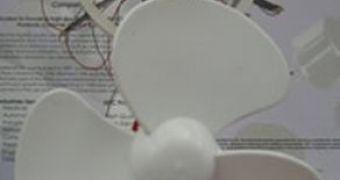The only renewable energy sources that are totally not contaminating and not affecting the habitat are the solar and wind powers. "After solar power, wind power is the most effective source of mechanical energy in nature. Solar energy is very cheap now, just $25 for a one-watt solar panel. They're a very effective source of power when you have sunlight. But if there's less light, their efficiency at generating power can go from about 10 % down to 3 %. If windmills can generate that amount of power or more, than they can become a helpful technology", said materials engineer Shashank Priya at the University of Texas at Arlington.
Miniature windmills could be employed to generate power where sunlight is not available, like in tunnels or the shadows of mountains or valleys, for fueling small devices like for home alarms, lamps, sensors for border security, weather stations or forest fires.
Tunnels are suited for windmills: there's no sunlight but "You can have cars passing at high speed through them, generating big gusts of wind. So you can imagine windmills inside to power the lights, replacing electrical wires that, if they caught on fire, would be hard to extinguish," Priya said. "You can imagine networks of sensors at national borders near forests that can transmit information wirelessly to the Internet," Priya said.
"Or you can imagine them helping monitor forests to capture information on fires as early as possible."
"You can think of them monitoring traffic in the mountains, powering red and green lights where sunlight doesn't reach the roads to let people know whether there's opposing traffic coming on the curving roads or not," he added.
Windmills could have home application as a supplement for solar panels "to help harvest power day and night. You can imagine the little windmills looking rather decorative at rooftops, lawns or backyards."
Windmills employ a completely different and new technology than the large windmills used in wind power farms, as the large ones do not function at small scale.
The key in windmills are the piezoelectric ceramics that turn mechanical stress or vibrations into electricity.
The best model for windmills so far proved to be the one with three aluminum alloy fan blades (the rest of the mill is made of plastic) that can catch wind from all directions, functioning with winds from 3 miles (5km) to 15 miles (25 km) per hour. The windmill has a size of 3.5 inches (9 cm) x 4 inches (10 cm) x 5.5 inches (14 cm), a little larger than a can of soda, and just 1.3 lbs. (0.5 kg) in weight.
The caught energy can be stored in batteries or supercapacitors and at 10 miles (16 km) per hour wind speed can produce 5 milliwatts of continuous power. To increase the captured power, the researchers will add magnetic elements to the piezoelectric components in future models. "These ought to boost windmill power roughly tenfold," Priya estimated. "We're getting very close to a cost-effective generator to make a commercializable system," Priya said.

 14 DAY TRIAL //
14 DAY TRIAL //